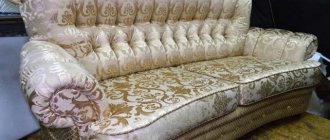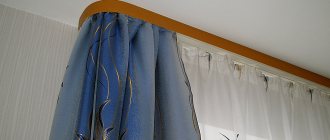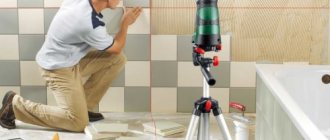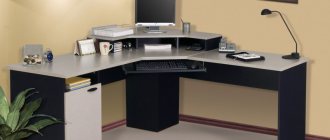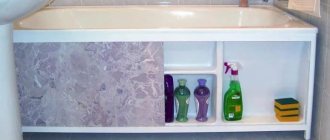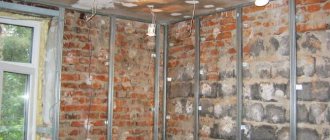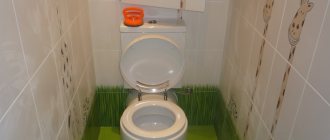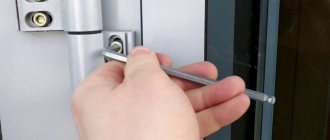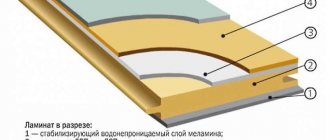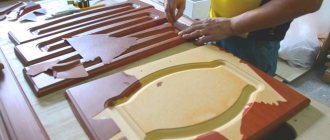People who are most often interested in how to glue ceiling tiles are those who do not like standard renovation solutions. Thanks to the ceiling cladding material, you can create unusual patterns, combine different colors and types, and place slabs in an unusual pattern, for example, diagonally. This scheme is not just a creative option, but also a useful one. Diagonal placement will help hide unevenness and other defects in the ceiling. The process of gluing slabs to the ceiling manually requires preliminary work.
It’s not enough just to choose suitable beautiful finishing options; you need to take into account all the pros and cons of this material, as well as the features of its gluing
Necessary tools and materials for work
Since you will have to glue the tiles to the ceiling with your own hands, you will need an impressive list of tools for the job:
- ladder;
- putty knife;
- sharp construction knife;
- brush;
- triangle;
- painting cord.
In addition to the auxiliary tools, you need to purchase ceiling tiles in quantities according to calculations, plus an additional few units for cutting. You will also need glue, which is usually offered directly in the store where the facing material is sold. Most often it is sold as a clear liquid in a plastic bottle.
Choosing adhesive for foam tiles
Main selection criteria:
- Fast polymerization. The fastening is carried out to a horizontal plane, until the glue dries, you will have to hold the element with your hands - this is inconvenient.
- Sufficient viscosity. Despite the lightness of the mass, it is still there and a very liquid composition will not hold the tiles on the ceiling. For massive lamellas, thick mixtures should be selected.
- Lack of color. If the adhesive bleeds through the tiles, the ceiling will look untidy. However, cladding for painting allows the use of cheaper mixtures; a layer of paint will hide all visual defects.
- Versatility to materials. Some types of glue adhere well only to certain types of material and do not “sit” on lime, chalk, metal, and concrete. You should choose a mixture that will firmly adhere the tiles to the ceiling in the room being renovated.
- No solvents in the tile composition. Expanded polystyrene is a material that cannot withstand contact with organic/inorganic solvents. The material will melt under the influence of the glue and, as a result, the cost of repairs will increase.
Advice! Experts advise choosing adhesive depending on the format of the surface where the installation will be carried out. If the ceiling base is smooth, the elements fit perfectly, the contact is maximum, but there is nothing for the glue to “catch onto.” When covering an old surface, the situation is the opposite - the unevenness of the base and the natural ability of the tiles to straighten also prevent the glue from setting. Thus, ideal smoothness and severe unevenness equally require a fast-drying and extremely viscous adhesive composition.
Taking into account all the necessary characteristics of the adhesive composition, the following options are suitable for a foam board:
- Universal. The name of the glue itself says that it will glue anything and everything. The composition is characterized by viscosity, fast drying time and relatively low consumption. The advantages are outweighed by one disadvantage - the strong smell of glue will require protective measures during work and careful ventilation after cladding.
- Polyvinyl acetate (PVA) or bustylate. No smell, good adhesive properties, affordable price, but higher consumption. To glue the tiles well, you will have to spread the glue over the entire surface of the element. PVA does not dry as quickly as the universal composition, and it can also show through thin elements over time.
- Liquid Nails. This is an option for a universal composition, but without a pungent odor. The mixture is expensive, but ease of use, the ability to simultaneously seal seams, and spot application are advantages that outweigh the high price.
- Acrylic putty. The composition is ideal for gluing transparent elements, installing skirting boards and moldings. It is characterized by relatively low consumption, low cost and ease of use. The thick composition is ready for use, can be applied with a spatula, does not show through the tiles when dry and, by the way, is also suitable for sealing joints.
A little about manufacturers of adhesive for foam tiles:
- Brand Titan. The mixtures are suitable for any surface; you can work in conditions with different temperatures and humidity. Product consumption is relatively low, while the composition is invisible and stable when the tiles get wet.
- The Master brand has also earned the approval of customers. Pros: low cost, dries quickly, adheres to any surface, allows for subsequent dismantling and displacement of elements. The downside is a persistent unpleasant odor.
- The Moment brand has long been known and enjoys wide popularity. High adhesion qualities, fast drying speed, low consumption are advantages. The downside is that it sometimes shines through the tiles. In addition, the speed at which the glue dries will be a disservice - it will no longer be possible to correct the mistake.
- A brand from Chinese manufacturers Elitance for those who want to get high-quality glue at a very low cost. Additional advantages: good adhesion, water resistance, the ability to seal seams, elasticity when hardening. In addition, such glue prevents the appearance of fungus and retains its quality under any climate fluctuations - the slabs do not warp or peel off even in the cold.
Some tips from the professionals:
How to stick ceiling tiles on old tiles and repair damage
- Read the instructions for use carefully: types of adhesive differ in application to ensure optimal adhesion.
- Polymer-based adhesives require a special technology: first, the element with the applied composition is applied, then removed for 60 seconds, and then glued again. The procedure helps dry the composition in order to increase its practical qualities.
- Optimal application of the composition - along the entire perimeter without breaks. Spot application of glue is possible only if the composition sets quickly, but the mixture is used on sufficiently thick slabs to minimize the risk of deformation during gluing.
- Before installing a new cladding, it is recommended to remove the old coating, even if it is firmly in place. It is impossible to predict the temporary service life of the old coating, especially when the ceiling cladding is heavier.
Important! Solid elements of polystyrene foam tiles fit perfectly, but cut fragments do not look so beautiful, plus the multiplicity of seams reduces the effect of the integrity of the ceiling. Therefore, it is recommended to start laying out from a corner that is immediately visible upon entering the room.
Safety precautions
When carrying out decorative work on surface gluing, follow the safety rules:
- Choose a stepladder that is reliable and does not wobble.
- Turn off the power supply when working near exposed wires or near a chandelier.
- Cover your breathing system when working with toxic glue.
- Use gloves to equip and protect your hands from injury.
It is also necessary to protect the respiratory system with a mask when cleaning the ceiling from old coatings
Injection
The production process uses the method of sintering polystyrene in molds under the influence of steam and cooling under pressure. The finished tile is white, rectangular or square in format, has a thickness of 9-14 mm, a deep, clear pattern on the front surface (including 3D format), can be laminated or uncoated.
Advantages:
- using products you can create a surface without visible seams;
- strength;
- moisture resistance;
- sound and heat insulation;
- due to its significant thickness, LED lamps can be installed inside the volumetric panels;
- environmental friendliness;
- Possibility of painting the cladding if necessary.
The main disadvantage of this type of tile is the high cost relative to stamped products.
Pros and cons of ceiling tiles
Among the advantages are:
- availability of finishing materials;
- possibility of attachment to any surface;
- ease of hiding area unevenness;
- ease of installation;
- short period of repair work;
- no need for repair skills;
- wide decorative possibilities, large selection of different types.
High-quality fire-resistant cladding material increases safety in the kitchen and other rooms.
Among the disadvantages:
- low moisture resistance;
- color change due to sun exposure;
- low resistance to mechanical damage;
- presence of unaesthetic seams.
In rooms with high humidity it is better to use extruded material.
Popular manufacturers
On sale you can choose ceiling tiles to suit every taste according to design, shape and price. Therefore, it is difficult to create a single rating - consumer preferences are different. Nevertheless, we will try to provide a list of the most popular manufacturers.
"Armstrong". Armstrong-type suspended ceilings quickly gained popularity among Russian consumers. The secret of success is a huge assortment, high strength, moisture resistance, and most importantly, prices. The manufacturer offers not only economy-class materials, but also expensive, elite (designer) materials.
The traditional properties of ceiling tiles are complemented by an acoustic effect and reflective properties (creating the illusion of limitless space). A variety of textures, colors and patterns allow you to fit the ceiling into any design. The tiles can have a simple pattern or a structure and texture that accurately imitates wood, stone and other natural materials.
"Albes." The Russian tile manufacturer maintains its position in the building materials market thanks to high quality products, affordable prices and a huge selection of textures and colors, including mirror surfaces.
The high strength of the tiles allows installation without waste due to deformation, cracking and chipping. Excellent design is complemented by resistance to open fire, excellent sound absorption, and good thermal insulation properties.
The products of the Albes production association can be described in three words: durability, originality, aesthetics.
"Knauf". Products from German manufacturers attract buyers with their tile finish, low flammability, good sound absorption, resistance to high humidity, and low thermal conductivity.
Designed for recording studios, concert halls, cinemas and other premises requiring good acoustics. For this reason, it is practically not used in private construction (can be found in home cinemas and rooms for singing or playing musical instruments).
It differs from competitors in shape, types of edges, perforation (round, square, made in the form of a pattern). Plus - you can paint it repeatedly.
"Format". New technologies (American equipment from COMMODORE Plastics) allow the group to supply tiles with the following performance indicators to the retail chain:
- thickness - 4-7 mm;
- clear geometric contours;
- uniform tone of the entire part;
- high level of sound insulation;
- low thermal conductivity coefficient;
- beautiful design;
- Possibility of butt gluing.
The finishing is suitable for both office and residential premises: living room, bedroom, children's room, kitchen, etc.
AMF. The collaboration of the two produced excellent results. The tile has a number of qualities that distinguish it from its competitors:
- rigidity and strength;
- absolute environmental purity (biosoluble mineral fiber, perlite, clay and starch are used);
- high level of moisture resistance;
- purity of color;
- good heat and sound insulation;
- durability;
- simple installation.
"Antares" (Omsk). The company produces high-quality stamped, injection and extruded tiles of various textures, colors, shapes and sizes. Well-established quality control eliminates the supply of defective products to the retail chain.
"Laguna", "Mivi", "Miwe". Chinese enterprises Laguna, Mivi, Miwe supply imitation expensive tiles (Armstrong, Rockfon, etc.) to Russia at low prices. In appearance, the tiles are difficult to distinguish from the original. However, in functionality and performance characteristics it is significantly inferior to the prototype, which, however, is compensated by its low cost.
Despite this, the product finds its buyer. Consumers especially like the following collections: “Lotus”, “Matrix”, “Neva”.
How to calculate the amount of material
Initially, calculate how many plates will be needed for the entire ceiling.
People with experience in repairs immediately buy 10-15% more than the calculated quantity in case of rejection, accidental deformation during use, or errors during cutting.
The calculation is quite simple. It is necessary to calculate the area of the ceiling and find out the size of each part. The standard size of the tiles is 50*50 cm. That is, the area of one plate is 0.25 m². To find out the required number of decorative parts, you need to divide the area of the ceiling by the area of one tile.
If the length of the ceiling does not match the equal number of slabs, gaps will remain during finishing. Therefore, the slabs will need to be cut. This nuance must be taken into account in calculations.
Material calculation
In the case of tiles, you need to buy them with a small margin. Calculation of materials must be done in advance.
How to do it:
- If the room is square, it is necessary to take into account the square footage and compare it with the size of the tile;
- If it is rectangular, the width of the room is multiplied by the length;
- Afterwards, the area of each section is specified and the values are added up (the final result is the number of required tiles individually).
The reserve is necessary not only for safety during installation. If there is excess left, you need to save it, since during use the surface may develop dents or unevenness.
Each tile can be replaced separately. There is no need to redo the entire ceiling installation if materials with the desired pattern are preserved.
Ceiling preparation
Before gluing the ceiling tiles, prepare the surface of the ceiling itself. To do this, clean it of all kinds of old coatings. This could be paint, whitewash, leftover wallpaper. Cover all irregularities and cracks in the ceiling with putty and prime the surface. To do this, you can use a regular standard primer from the store or dilute the glue with water.
All work can be divided into several stages:
- Using a spatula, remove whitewash and any other coating residues from the ceiling.
- Using the same metal tool, apply a thin layer of putty and wait until it dries.
- Using a brush, apply primer over the putty.
To ensure that the ceiling tiles remain securely on the ceiling, place them on a flat, dried, cleaned and grease-free surface.
On what surfaces can and cannot be glued?
Before installing the tiles, be sure to evaluate the existing ceiling covering: first of all, it must adhere well, not peel off, and look reliable.
The second stage is determining the type of coating, because even though the tiles are light, they cannot be glued to every base.
- Whitewash. The chalk one will definitely have to be washed off - the glue will not stick to it. Limestone, if applied in a thin layer and holds tightly around the entire perimeter, can be left.
- Painting. The same question as for limestone - if it doesn’t peel off, you can glue it on top.
- Wallpaper. Removal before starting work is mandatory.
- Plaster. Not the best base for an adhesive composition; it is better to treat it with a thin layer of putty.
- Putty. Ideal for gluing polystyrene foam boards.
Types of glue
The most popular adhesive for attaching square ceiling plates is the special transparent “Moment”. No less common are similar varieties “Titan” and “Eco-Naset”, which have an increased setting time. When used correctly, each of the selected products ensures a high level of reliability.
Depending on the type of room in which the ceiling tiles will be glued, it is necessary to select a modification of the adhesive. For the kitchen, choose compositions with high moisture resistance.
There are these types of glue:
- Universal polymer ones
, which include the listed varieties “Titan”, “Master”, “Dragon”, “Power”. They differ in efficiency and cost. - Liquid Nails
– difficult to use glue. It is applied only in a thick layer, which makes it difficult to place the facing material perfectly evenly. It is better to choose white liquid nails.
When choosing liquid nails for gluing briquettes, pay attention to the composition. Some of them contain solvents, which will further deform and corrode the material of the slabs. - Polyvinyl acetate compounds
are the most popular types of bustylate, PVA, and the like. They have a certain advantage in the absence of an unpleasant odor. However, its consumption is much higher. - Acrylic putty
provides excellent adhesion to any surface and has several advantages. The white color of the putty will be invisible even when choosing the thinnest types of slabs. Putty can also be used for its intended purpose - for grouting joints.
Cleaning and caulking joints
After gluing the panels, it is necessary to clean the surface of any glue that accidentally gets on it or protrudes along the seam. It needs to be removed completely and this matter should not be put off for a long time. Wipe it off with a damp sponge or soft, non-fading cloth. A few seconds of delay can cause the stains to harden and become impossible to remove. So keep a rag and a bucket of water nearby while you work, and remember to clean each tile immediately after gluing.
If you couldn't lay the tiles closely, that's okay. Fill small voids with the mastic used for installation, or putty if it matches the color of the tile. It is good to mask the seams with white acrylic sealant. It adheres well to facing materials and perfectly hides all the cracks. Use a small rubber spatula to fill gaps. Once you have sealed the seam, immediately wipe off the excess with a damp sponge or rag. If the seams are sealed carefully, they will not spoil the appearance of your ceiling.
Two gluing technologies
There are two main pasting patterns: from the center or from the corner. It is important to understand how to properly glue ceiling tiles using each method.
I. Pasting from the center
The method of gluing from the center includes the following steps:
- Start laying the ceiling surface elements from the center to the edges. The midpoint is determined by the point of intersection of the diagonals.
- Through the central point, draw two perpendiculars to the walls to divide the area into 4 parts.
- Then lay the products from the center along these lines in parallel.
II. Diagonal pasting
The diagonal method of decor placement implies:
- Angle separation at 45°.
- Laying lines diagonally to connect them.
In the photo you can see the diagonal layout of the slabs on the ceiling. At the same time, the seams between them are sealed with sealant.
This technique is necessary for a square-shaped room. If the room has a rectangular shape, then it is necessary to carry out markings similar to the method of pasting from the center. But in addition it is necessary to divide the resulting 4 right angles by diagonals.
In the second option, the base corner of the room is selected. This is the one that is clearly visible when entering the room. A 1 cm mark is placed perpendicularly on the base wall adjacent to it. Then the thread is stretched and secured with tape. It will be a guide, allowing you to start work from the very corner. It is better to do this with 2 or 3 tiles.
Be sure to mark before starting work. It is possible to discover wall unevenness too late, and it will be problematic to correct the work already done. Huge gaps will form on the wall that will be difficult to disguise.
Layout options
You can glue foam ceiling tiles in different ways. Basic layout schemes:
- Stripes. The method of laying squares in straight lines is both simple and problematic. The slightest mistake will lead to discrepancies in the gaps and a damaged design.
- Shift rows. The shape of the sticker resembles brickwork. Typically, one row is shifted 50% relative to the other, but you can experiment with a shift of 25-33%.
- Diagonal. To make the interior more dynamic, glue it diagonally, placing it at an angle of 45 degrees to the walls.
What to do if the ceiling is not level
First of all, decorative plates are designed to solve the problem of uneven ceilings. If the defects and irregularities are minor, then these elements can easily hide them. To do this, you need to choose not just flat products, but curly ones. It is enough to take standard glue, since gluing ceiling tiles to an uneven surface is just as easy as to a regular one.
Question:
How to glue ceramic or metal tiles to an uneven ceiling?
Answer:
If the tile is made of ceramic or metal, it will not adhere to an uneven surface. There are two ways out of this situation: you can level the ceiling using building materials or install a foam or metal frame.
Advantages and disadvantages
Ceiling tiles are produced using high-tech modern equipment, which allows us to ensure a high-quality structure and high performance indicators of the material. She has many advantages, including:
- wide variety - products vary in composition, shape, style, texture, patterns and colors. Can imitate wood, mirror, metal, fabric, leather;
- wide design possibilities - you can lay and combine the material in a variety of ways;
- variety of shapes - in addition to the standard, there are many options for designer tiles, which allow you to create a unique finish in any style, taking into account the characteristics of the ceiling;
- light weight - allows the use of glue for fastening;
- ease of installation - even a non-professional can handle it, and it’s quite possible to do it alone;
- good thermal insulation ability - this is especially noticeable in winter;
- soundproofing properties are an excellent bonus for getting rid of extraneous noise;
- Possibility of painting in any color;
- a wide range of products can be found in any building materials store;
- low cost - accessible to most buyers;
- fits perfectly into the interior of any room in the house. It is quite appropriate in the living room, office, nursery, bedroom, kitchen, hallway, bathroom, toilet. The variety of products allows you to choose the best option for any room.
However, this type of finishing also has its disadvantages:
- the material often has to be calibrated because it may not be identical. As a result, the installation process may be delayed;
- Some types of tiles are highly fragile and may break. This leads to an increase in the percentage of defects and higher repair costs;
- To prevent the tile from deforming, it is necessary to carefully select the type of glue for each type of material;
- When glue gets on the front side, it is often impossible to remove it without leaving a trace without damaging the surface. We recommend that installation be carried out as carefully as possible;
- tiles from the porous category can shrink when adhesive is applied and allow it to leak out.
Technique for gluing a flat ceiling
The technique does not require any additional steps and is the simplest. Ceiling tiles are glued immediately after applying the adhesive. The products must be pressed tightly to the ceiling surface and held for several minutes. You can proceed to installation of the next element.
Work order:
- Place the first part at an angle exactly to the center according to the chosen pattern.
- The first four elements must be located strictly in the marked square with maximum accuracy.
- Gradually the entire ornament is laid out towards the corners or walls.
- Fill the remaining small free parts with pieces of tiles cut using a paint knife.
- Fill any gaps at the joints with acrylic sealant.
Leave a gap of no more than 15 mm between the final tile and the wall so that it can be covered with a skirting board.
Where to start gluing tiles
When choosing a location, professional tilers take into account some nuances relating to a particular room.
Take into account the size, shape of the room, as well as the location of the main lighting fixtures. In each situation, only one of the below presented schemes for starting to apply elements is ideal.
From the center of the room
The method of gluing tiles to a ceiling of this type is used most often, because the final appearance of the ceiling is very attractive.
After determining the central point of the room, you can begin to apply markings; the first 4 squares are fixed so that the corners are in close proximity to the chandelier mount.
Further, the symmetrically laid slabs will complement each other, and the cut pieces will stand near the wall, without attracting much attention from people.
From the center tile
When we glue foam plastic to the ceiling, adhering to this pattern, the first copy of the facing material is fixed exactly in the center of the room, and the remaining rows begin to move away from it.
A lot depends on the markings; it is important to clearly and correctly find the middle of the ceiling, and it is rarely possible to do without dismantling the chandelier, which complicates the process of applying squares.
The hole in the middle of the foam board should also be made carefully, but most often this place is covered by the lighting fixture mount, so mistakes can be hidden with a cap.
From the chandelier
In situations where a person is thinking about how to glue slabs to the ceiling and sees that the chandelier is not in the center of the room, but is shifted, then the previous methods will make the design unaesthetic.
The light source should act as a kind of guide, the first 4 elements should be placed with their edges at the frame attachment point, and the repair should continue, starting from these strips.
From the corner
You can glue ceiling tiles in this way and highlight the most successful area of the interior in a small room, taking visitors’ eyes away from nondescript areas.
It is necessary to choose the angle that first catches the eye from the doorway; excessive consumption of material in such a scheme is rarely noticed.
Pasting on whitewash
You can consider a way to glue ceiling tiles directly onto the whitewash with your own hands. There are two ways to do this.
I. Using primer
The first method is to apply a primer over the remaining whitewash. It will ensure good adhesion of the slabs to the main surface. You just need to wait for it to dry completely.
II. Removing the whitewash layer with a spatula
The second option involves removing part of the whitewash layer using a spatula. Then a significantly larger amount of glue than usual is applied to the underside of the slabs. The pressing period during gluing increases. This technique allows the glue to penetrate through the remaining layer of whitewash and bond the slabs to the ceiling.
Recommendations for further finishing
Many experts recommend immediately painting unpainted ceiling tiles after gluing or covering them with decorative protective film (do-it-yourself lamination). This allows you to solve several problems:
- protect the foam from mechanical damage;
- strengthen the surface structure;
- increase operational life;
- make cleaning easier, especially in the kitchen, where large amounts of grease settle on the ceiling;
- change the ceiling design.
Painted tiles are repainted after a few years, when the owners get tired of the old color scheme or the ceiling is dirty and cannot be washed.
Grouting joints
You can seal the seams on the ceiling surface between the slabs using putty or construction foam. This is the most popular and fastest method that allows you to get rid of even deep cracks.
All gaps formed between the slabs can be masked using white sealant. But it will be appropriate only if you choose white briquettes.
Tips for use
Polystyrene boards accumulate static electricity, which attracts dust, volatile fats, small particles of tobacco smoke, and soot to the surface. If timely cleaning is not carried out, the ceiling quickly loses its original appearance. Regular cleaning helps restore bright colors or whiteness to tiles: dry cleaning or washing. For this you will need:
- vacuum cleaner with a soft brush;
- detergents that dissolve grease and remove other types of contaminants (“Myth”, “Fancy”, “Eared Nanny”, “Sorti” and similar);
- a basin or bucket with warm water;
- a small brush (you can use an old toothbrush) to remove dirt from hard-to-reach places;
- foam sponge or cotton rag;
- dry absorbent cloth;
- paper napkins or towels.
You can get the desired effect by following the following recommendations:
- Porous and matte tiles can only be cleaned with a vacuum cleaner or wiped with a dry cloth (sponge). In case of severe contamination, paint with acrylic water-based paints;
- remove stains that appear immediately: first try with a stationery eraser, then, if that doesn’t work, wash;
- Abrasive materials and all types of washing powder are unacceptable - they destroy the structure of the tile;
- avoid heavy contamination. To do this, clean the ceiling at least once a month with a vacuum cleaner with a soft fluffy brush attachment;
- wet cleaning is carried out 1-2 times a year with a well-wrung out cloth. After washing, wipe the tiles with a paper towel or napkins. Otherwise, divorces may remain;
- A specially impregnated sponge will help remove soot;
- Warm salted water removes slight yellowness;
- For white surfaces, you can use bleach.
Should I paint ceiling tiles and how to do it?
Sometimes it's easier to repair something old than to buy new. The same rule applies to ceiling tiles. Some of them can and should be painted to revive the surface of the ceiling. Plastic and laminated products cannot be painted. But foam tiles are perfect for painting, which can be done with a brush, sprayer or roller.
Types of polystyrene foam tiles
High-quality polystyrene foam tiles are a material that consists of foam capsules filled with gas. Foamed products are lightweight, and the low percentage of raw materials (5%) explains the affordability of the material. There are several types of foam ceiling tiles on the market:
- Pressed. The production uses the mechanical stamping method. The thickness of the elements is 6-8 mm, the price is from 2-3 $, the option is considered the most budgetary. The disadvantage is the somewhat inexpressiveness of the design and relief of the tiles.
- Extruded. The manufacturing technology requires the use of special equipment - an extruder, through which strips of raw materials are extruded, then formed into slabs. The end result is a product with a shiny, smooth surface and a convex texture. Manufacturers often offer extruded ceiling tiles with imitation stucco, patterned ornaments, natural materials: marble, granite, wood and much more. Tile thickness up to 12-14 mm, price from $4. Additional advantages of the product include a high level of density and low porosity of the structure.
- Injection. The manufacturing technology repeats the process of metal casting: raw materials are poured into a prepared mold, where they harden. The result is a smooth textured tile 9-14 mm thick. The price of the material is from $3-5.
Ceiling tiles also differ according to their production method:
- Stamping. Processing is carried out with a stamping press, the matrix of which has a textured ornament. The slabs are smooth, but the small variety of matrices does not allow increasing the range of products. Stamped tiles do not differ in texture, relief, or texture. The material is suitable for users choosing cladding in a minimalist style. In addition, the products are very inexpensive.
- Casting. Such tiles are a little more expensive, but are produced by casting (injection). Thanks to the ability to cast a variety of shapes and the inexpensive cost of the mold, the products are distinguished by greater variety and improved quality.
Knowing what types of polystyrene foam tiles there are, it is easy to choose a cladding option. The advantages of the material are numerous; the disadvantage may be low bending strength. However, the ability to perform facing work with your own hands and the extremely affordable price of repairs make up for all the possible disadvantages of the product.
As for the grade of products, there are three of them: extra, first and second grade. The options are arranged according to the level of defects and their prevalence. For subsequent painting, grade 2 material is suitable, but it is important to choose tiles with fewer chips, irregularities and kinks.
Care and maintenance of ceiling tiles
In order for the tiled ceiling to look neat and well-groomed, it is necessary to periodically carry out the following activities:
- vacuum the surface to increase the period between wet cleaning;
- It is not recommended to wash any stamped tile to prevent its deformation;
- remove remaining grease stains with alcohol;
- To update the color of painted products, apply a new layer perpendicular to the previous one.
To preserve the appearance of the tiles, periodically wipe the slabs with a damp cloth, without using aggressive or abrasive products.
Painting tiles on the ceiling
After correcting the defects that arose with the seams, if desired, decorate the surface, you can paint the tiles.
For this purpose, for example, a water-based composition based on latex or acrylic is used, which has the following advantages:
- does not have a pungent odor;
- It is resistant to wet cleaning.
Before painting, a primer is applied to the surface of the tile. It is advisable to use a roller with a foam surface. In order for the composition to hold firmly, you need to apply at least two layers of paint. The result is a unique design, striking in its originality.
